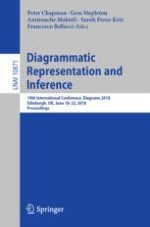2018 | OriginalPaper | Chapter
A Typology of Mathematical Diagrams
Authors : Mikkel Willum Johansen, Morten Misfeldt, Josefine Lomholt Pallavicini
Published in: Diagrammatic Representation and Inference
Publisher: Springer International Publishing
Activate our intelligent search to find suitable subject content or patents.
Select sections of text to find matching patents with Artificial Intelligence. powered by
Select sections of text to find additional relevant content using AI-assisted search. powered by
